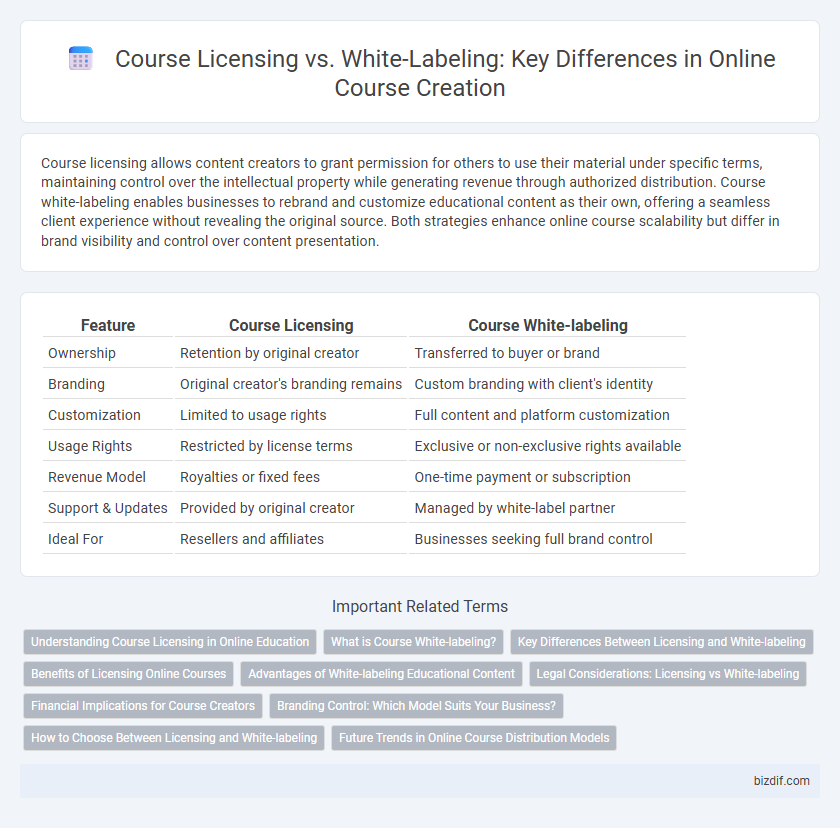Course licensing allows content creators to grant permission for others to use their material under specific terms, maintaining control over the intellectual property while generating revenue through authorized distribution. Course white-labeling enables businesses to rebrand and customize educational content as their own, offering a seamless client experience without revealing the original source. Both strategies enhance online course scalability but differ in brand visibility and control over content presentation.
Table of Comparison
| Feature | Course Licensing | Course White-labeling |
|---|---|---|
| Ownership | Retention by original creator | Transferred to buyer or brand |
| Branding | Original creator's branding remains | Custom branding with client's identity |
| Customization | Limited to usage rights | Full content and platform customization |
| Usage Rights | Restricted by license terms | Exclusive or non-exclusive rights available |
| Revenue Model | Royalties or fixed fees | One-time payment or subscription |
| Support & Updates | Provided by original creator | Managed by white-label partner |
| Ideal For | Resellers and affiliates | Businesses seeking full brand control |
Understanding Course Licensing in Online Education
Course licensing in online education allows educators to grant specific usage rights of their course content to third parties while retaining ownership and control, ensuring protection of intellectual property. This approach enables content creators to monetize their courses through defined terms such as duration, scope, and audience access without transferring complete control. Understanding course licensing is essential for maintaining course integrity, expanding distribution channels, and maximizing revenue streams while safeguarding educational assets.
What is Course White-labeling?
Course white-labeling allows creators to rebrand and customize an online course platform entirely under their own brand, offering a seamless experience for learners while hiding the original provider's identity. This approach empowers businesses to maintain brand consistency and build trust with their audience by delivering courses that appear fully proprietary. Unlike standard course licensing, white-labeling provides complete control over course aesthetics, domain, and user experience, enhancing brand authority and customer loyalty.
Key Differences Between Licensing and White-labeling
Course licensing grants the buyer the right to use and sell the course content under the original creator's brand, maintaining the creator's identity and control over updates. In contrast, course white-labeling allows buyers to rebrand the course entirely as their own, including customization of logos, colors, and sometimes content modifications, offering a seamless brand experience. Licensing typically involves less customization but faster deployment, while white-labeling provides greater brand integration and personalization for the reseller.
Benefits of Licensing Online Courses
Licensing online courses allows educators to reach a broader audience by granting rights to third parties to distribute or use the content, ensuring revenue generation without the need for ongoing involvement. This method provides consistent brand control and intellectual property protection while enabling scalable income streams. Furthermore, licensing offers flexibility in partnership terms, facilitating market expansion and enhanced course accessibility.
Advantages of White-labeling Educational Content
White-labeling educational content allows creators to customize course materials with their own branding, enhancing brand recognition and trust among learners. This approach offers greater control over the user experience, enabling seamless integration into existing platforms without third-party logos or links. White-labeling fosters scalability by allowing resellers or partners to market the course as their own, expanding reach and generating additional revenue streams.
Legal Considerations: Licensing vs White-labeling
Course licensing grants permission to use copyrighted course material under specific terms, retaining ownership and control over content distribution. White-labeling involves rebranding and modifying the course as one's own, raising complex legal issues regarding intellectual property rights and liability. Clear contractual agreements are essential to define usage rights, responsibilities, and limitations in both licensing and white-labeling arrangements.
Financial Implications for Course Creators
Course licensing typically involves course creators granting permission for others to use their content in exchange for royalties or licensing fees, providing a steady stream of passive income while maintaining control over the course material. White-labeling allows third parties to rebrand and sell the course as their own, often leading to larger upfront payments or revenue shares but reducing the creator's visibility and direct customer relationship. Understanding these financial implications helps course creators choose between ongoing earnings with licensing or potential higher immediate revenue through white-label partnerships.
Branding Control: Which Model Suits Your Business?
Course licensing grants businesses the right to use and distribute a course while maintaining the original creator's branding, offering limited control over customization. Course white-labeling allows companies to rebrand and tailor the course content fully, providing maximum branding control and seamless integration with their existing offerings. Businesses seeking comprehensive brand alignment and personalized learner experiences typically prefer white-labeling over licensing.
How to Choose Between Licensing and White-labeling
Choosing between course licensing and white-labeling depends on your brand control and customization needs; licensing offers limited modification rights while white-labeling allows full rebranding and content adaptation. Evaluate your target audience's expectations and the level of technical expertise available to manage the course platform. Assess cost implications and long-term scalability to determine which model aligns with your strategic goals and marketing approach in online course creation.
Future Trends in Online Course Distribution Models
Course licensing allows institutions to sell or distribute pre-made content while retaining copyright, enabling scalable revenue streams without content redevelopment. White-labeling offers partners full customization of courses under their brand, enhancing flexibility and market reach in diverse niches. Future trends indicate a hybrid approach combining both models with AI-driven personalization and blockchain for secure, transparent licensing in online course distribution.
Course Licensing vs Course White-labeling Infographic

 bizdif.com
bizdif.com